Japan
Wood Products Prices
Dollar Exchange Rates of 10th
Feb
2025
Japan Yen 152.50
Reports From Japan
Tourism boost for
hospitality accommodation
In 2024 the weak yen fueled a tourism boom with more
than 36 million people visiting the country according to
the National Tourism Organization. Spending by foreign
visitors surged to 8.14 trillion yen (US$51.78 bil.), a 50%
plus rise from the previous year.
While the influx of visitors has delivered a boost to
Japan’s economy after decades of stagnation the surge in
arrivals has also prompted pushback among locals.
There is a growing demand for hospitality
accommodation, creating opportunities for the wood
products sector, however, rising construction costs and a
shortage of builders are holding back the supply of new
properties leading to more renovation and rebranding of
existing properties.
Pre-pandemic there was considerable investment in hotels
but during the pandemic many were converted into other
uses. Now there is a shortage, especially in the few top
tourist destinations according to analysts at TTG Asia who
recommend potential investors should work with local
governments to promote second and third tier cities
because they are important for the long-term sustainable
growth of tourism.
See:https://www.aljazeera.com/economy/2025/1/15/japans-
tourist-arrivals-hit-all-time-high-as-weak-currency-draws-masses
and
https://www.ttgasia.com/2024/10/23/bright-future-for-japans-
hotel-market/
Pay increases failing to keep pace with rising prices
Ministry of Health, Labor and Welfare data shows real
wages fell in 2024 marking the third consecutive year of
decline as pay increases failed to keep pace with rising
prices. Nominal wages or the average total monthly
earnings per worker including base and overtime pay
increased 2.9% to 348,182 yen last year, expanding for the
fourth straight year but consumer prices outpaced wage
growth with a 3.2%.
The Chief Economist at Mizuho Research and
Technologies considers inflation might be tougher to tame
than expected, putting real wage growth at risk and
possibly becoming a drag on the all-important household
consumption. Although the Bank of Japan forecasts a
slowdown in food price growth and overall inflation from
the second half of 2025 this may not happen.
Japan struggled with deflation for decades and kept
interest rates at or near zero for years to get prices rising
again. They are now increasing and are becoming an issue
for workers who are finding their wages barely growing or
actually declining month to month on a real basis, says
Mizuho Research.
See: https://japantoday.com/category/business/update2-japan-
real-wages-drop-for-3rd-straight-yr-in-2024-as-inflation-bites
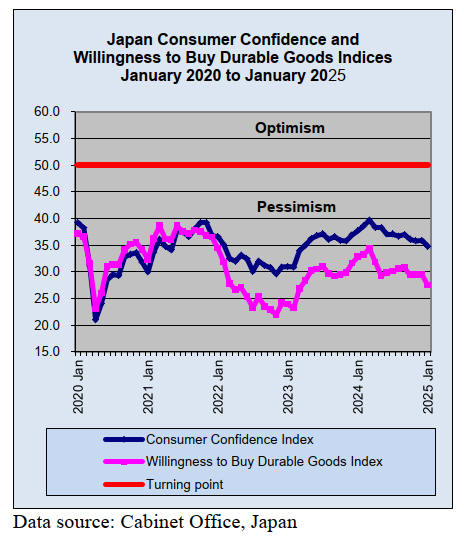
Weak yen increasingly burdensome
After Bank of Japan (BOJ) raised short-term interest rates
to 0.5% last month, expectations grew that the Bank may
raise rates faster and higher which could drive the yen to
rise against the US dollar.
However, in early February the dollar rose to a one-week
high against the yen as a rapidly rising consumer prices in
the US raised expectations that interest rates will not be
lowered any time soon.
Declines in the yen's "real strength" are standing out amid
its ongoing depreciation and years of deflation. In a
monthly index released by the Bank for International
Settlements (BIS) showing the effective value of the
currencies of 64 countries and regions around the world,
the yen has continued to see the biggest declines. As Japan
relies heavily on imports for essential goods like food and
energy.
See:
https://mainichi.jp/english/articles/20240625/p2a/00m/0bu/02400
0c
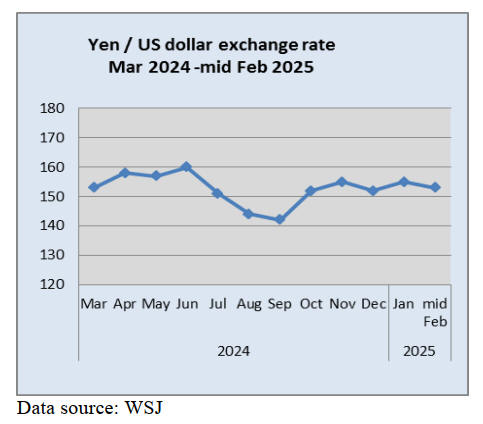
Owners of new buildings to be required to
calculate
lifetime CO2 emissions
The government is considering a plan to require home
owners and builders to calculate the amount of carbon
dioxide that will be emitted when constructing, managing
or demolishing buildings. The government hopes to
submit a bill to the Diet session in 2026. According to the
International Energy Agency the buildings sector
accounted for nearly 40% of global CO2 emissions in
2022.
Owners of new buildings over a specified size will be
required to calculate the project’s lifetime CO2 emissions
as part of a life cycle assessment. CO2 emissions would be
calculated at all stages of a structure’s lifecycle from
procurement and the manufacturing of materials to
construction, use, repair, maintenance and demolition.
See: https://japannews.yomiuri.co.jp/politics/politics-
government/20250106-231678/
and
https://www.iea.org/data-and-statistics/charts/global-co2-
emissions-from-buildings-including-embodied-emissions-from-
new-construction-2022
A first in housing subsidies
Takashi Ishizuka reports that a city neighboring Tokyo
will be the first in Japan to offer housing subsidies, not
just to newlyweds but also to residents preparing for
marriage.
The Ichikawa Municipal authority introduced the initiative
in February to support young couples, promote settlement
in the city and address declining birth rates. The
programme, which supplements a national initiative for
newlywed support, will also provide assistance to couples
in the premarital stage, a first in Japan. The programme
covers two groups, couples renting a home together before
marriage and newlyweds renting after marriage.
See:
https://mainichi.jp/english/articles/20250207/p2a/00m/0na/00800
0c
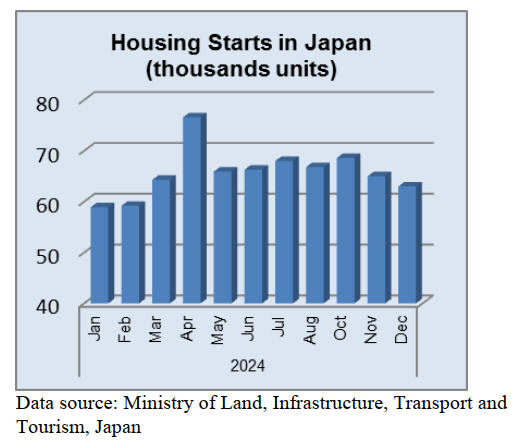
Affluent foreigners choosing Japan for luxury homes
Affluent foreigners seeking home options are increasingly
choosing Japan. The new arrivals in cities such as Tokyo
and Osaka are upending the luxury housing market.
Chinese already make up the largest group of foreigners in
Japan. Until recently, the previous generation of Chinese
immigrants tended to be students, interns and labourers.
The investment migration consultancy Henley & Partners
predicted that China would rank top in terms of the
outflow of high-net-worth individuals (those with
investable assets of US$1 million or more).
Many Chinese are arriving in Japan under the business
manager visa which requires at least yen 5 million in
investments or the highly skilled foreign professional visa.
See:
https://www.japantimes.co.jp/news/2023/11/28/japan/society/chi
nese-immigrants-new-
wave/?utm_medium=email&utm_source=pianoex&utm_campai
gn=379845623701
Import update
Assembled wooden flooring imports
The value of imports of assembled wooden flooring
(HS441871-79) surged in November rising just over 30%
from a month earlier. In the second half of 2024 the yen
strengthened against the US dollar making imports
cheaper than in the first half of the year.
The main category of assembled flooring imports was
HS441875 accounting for 64% of the total value of
assembled flooring imports compared to the 74% share
reported in October. Of HS441875 imports 65% was
provided by shippers in China and 26% by shippers in
Vietnam. The two other main sources of assembled
flooring (HS441875) in November were Malaysia and
Indonesia.
The second largest category in terms of value in
November was HS441879, 8% (13% in October), the
second monthly decline. The third category of imports was
HS441873 all of which was shipped from China.
Year on year, the value of assembled wooden flooring
(HS441871-79) in November was up around 25%.
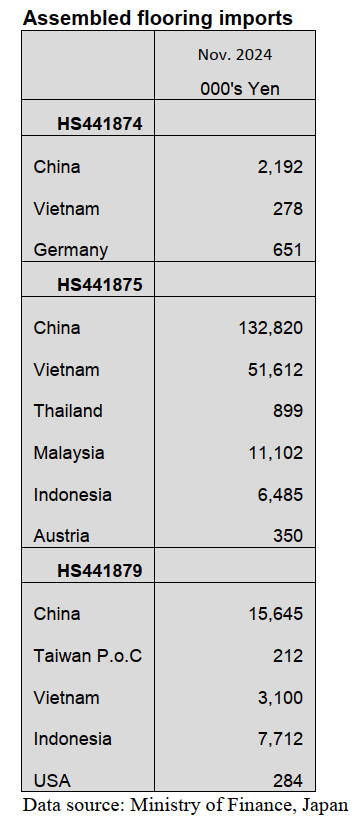
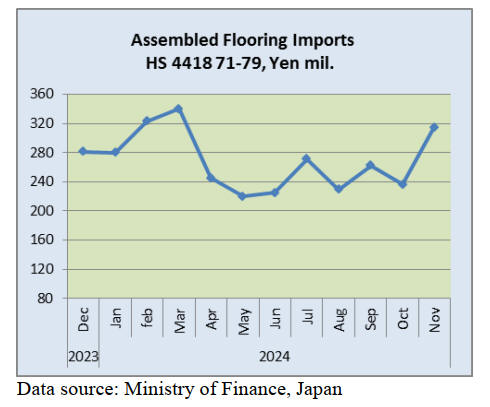
Plywood imports
The volume of November plywood imports (441210-39)
was 126,0020 cu.m (122,810 cu.m in October). This was
around the same level as in November 2023.
Malaysia and Indonesia hold a significant share of Japan’s
plywood imports and in November 2024 accounted for
almost 80% of the total volume of plywood imports. The
other two major suppliers of plywood to Japan in
November 2024 were Vietnam and China.
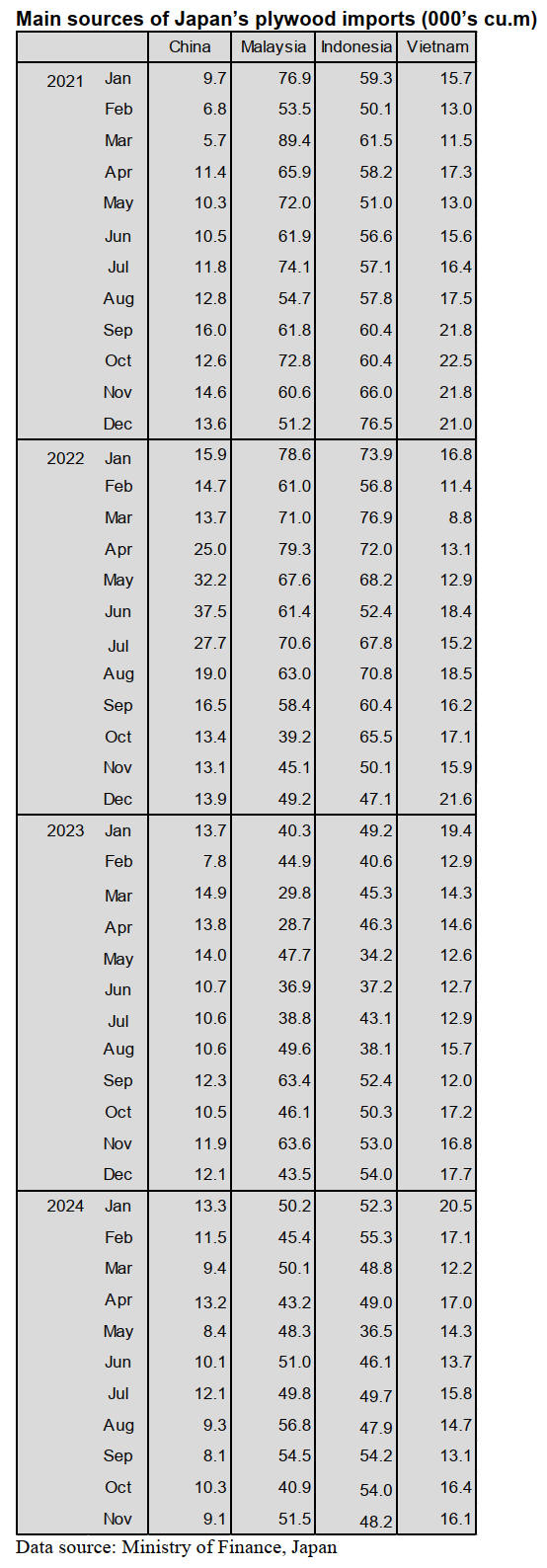
Arrivals from Vietnam in November totaled 16,075
cu.m,
almost the same volumes as imported in October. Arrivals
of plywood from China amounted to 9,077 cu.m.
Year on year, all but one of the top four suppliers saw a
decline in November import volumes. Month on month,
shipments from Vietnam were maintained but shipments
from Malaysia increased. As in previous months, of the
various categories of plywood imported in November
HS441231 was the largest (87% of total imports) followed
by HS441234 (6%), HS441233 (5%) and HS441239 (2%).
Malaysia and Indonesia accounted for most of the
HS441231 arrivals. Shipments from Vietnam and China
were spread across the categories tracked except in the
case of HS441273 for which China was the only shipper.
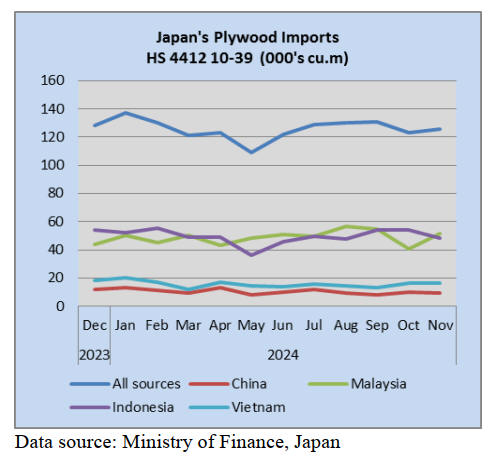
Trade news from the Japan Lumber Reports (JLR)
The Japan Lumber Reports (JLR), a subscription trade
journal published every two weeks in English, is
generously allowing the ITTO Tropical Timber Market
Report to reproduce news on the Japanese market
precisely as it appears in the JLR.
For the JLR report please see:
https://jfpj.jp/japan_lumber_reports/
Projection of import wood products
The Japan Lumber Importers Association disclosed
projection of imported wood products for 2024 and the
first half of 2025.
Volume of logs will decrease by 13 % in 2024 but volume
of lumber will increase by 17.2 % in 2024. Volume of
lumber in the first half of 2025 will be 12.5 % less than the
same period last year.
Volume of North American lumber in 2024 is 15.8 % less
than the previous year because a major Douglas fir lumber
manufacturer, Chugoku Lumber Co., Ltd., reduced
production. Chugoku Lumber stopped producing lumber
due to the fire occurred at one of its plants, Kahima plant
inAugust, 2023. Additionally, some other lumber
manufacturers reduced production and the price of
softwood structural plywood dropped.
Also, the sales of softwood structural plywood were not
good so plywood manufacturers stopped using Douglas fir
logs.
Consumers started to purchase domestic logs instead of
NZ logs but radiata pine logs for lumber are popular in
Susaki city, Kochi Prefecture. Volume of South Sea logs
was minimum. There were no Russian logs due to
prohibited exports from Russia.
Imported wood products in 2024 increased except South
Sea products. Volume of glulam is 15.6 % up and of
Russian products is 14.2 % up because the volume of these
products was very low in 2023. European products and
glulam increased because Japanese importers did not order
a lot due to the weak yen and over-stocking in 2023.
Moreover, it was unable to pass the Suez Canal due to
conflicts in the Middle East. Also, there were many
containers from China.
As a result, demand and supply of lumber were
unbalanced because of containers from Europe and China
arrived at once. As for Russian lumber, taruki is still very
popular and the price is high so there are a lot of imported
taruki. North American lumber had been purchased to fill
the inventories but demand for 2 x 4 was stable. A
projection for supplying of imported lumber at the first
half of 2025 will decline by 12.5 % and of imported logs
will rise by 3 %. All kinds of lumber will decline except
NZ and Chilean lumber.
European lumber has been declining since last October
and the inventories will be controlled. Also, the
inventories of North American lumber will be controlled
but it depends on the tariff on wood products between
Canada and the U.S. Lumber manufacturers in Europe and
North America would reduce operations due to high-
priced logs, low-priced lumber and the tariff problem
between Canada and the U.S
Plywood Domestic plywood manufacturers still raise the
price of domestic softwood plywood in February, 2025.
They will raise the price of 12 mm 3 x6 to 1,000 – 1,050
yen, delivered per sheet, from 950 – 980 yen, delivered per
sheet.Some of them plan to raisethe price in March, 2025.
Inquiries to softwood plywood are firm. It is hard to say
that demand for houses is lively but consumers started to
purchase plywood because their inventory became less and
less.
Imported plywood, which was purchased when the yen
was 150 yen against the dollar, has been delivered to
Japan. 12 mm 3 x 6 painted plywood for concrete form
costs 1,850 yen,delivered per sheet.
Form plywood is 1,550 yen, delivered per sheet. Structural
plywood is 1,550 yen. 2.5mm plywood is 750 yen,
delivered per sheet.4mm plywood is 930 yen, delivered
per sheet.5.5 mm plywood is 1,100 yen, delivered per
sheet.
The futures price of some plywood is more than the
price
in Japan so consumers hesitate to purchase plywood.
Malaysian or Indonesian plywood manufacturers expect to
raise the price due to high-priced logs and production
costs. However, Japanese buyers are reluctant to purchase
due to the weak yen.
The price in South Asia is leveled off. 12 mm 3 x 6
painted plywood for concrete form is $580 – 600, C&F per
cbm. Form plywood is US$490–510, C&F per cbm.
Structural plywood is US$500 – 520, C&F per cbm. 2.4
mm 3 x 6 is US$970, C&F per cbm. 3.7 mm plywood is
US$880, C&F per cbm. 5.2 mm plywood is US$850, C&F
per cbm.
Domestic logs and lumber side and it is difficult to cut
down trees.In northern part of Kanto region, 3 m cedar log
is 18,500 yen, delivered per cbm. It is 15,000 yen,
delivered per cbm in Kyushu region.3m medium diameter
cedar log is 17,000 yen, delivered per cbm in the northern
part of Kanto region and is 13,000 – 14,000 yen in Tohoku
region.
In Kyushu region, it is 14,500 yen, delivered per cbm. In
Shikoku region, it is 18,000 – 19,000 yen, delivered per
cbm due to snowfall.
4 m cypress log for sills costs 26,000 yen in Chugoku
region and this is 4,000 yen more than last time. It is
24,500 yen and it is 500 yen up in the northern part of
Kanto region. It is 25,000 yen in Kyushu region and it is
1,000 yen up from last time. Compared to last year, the
price of cedar log in Tohoku and Kyushu regions is 1,000
yen down but the price in the northern part of Kanto
region is 2,500 yen up. Cypress log is 1,000 – 2,000 yen
down in Tokai region and Western Japan.
However, it is 3,000 yen up in Chugoku region and is
2,500 yen up in the northern part of Kanto region. It is
2,000 yen up in Kyushu region.
Domestic lumber is in short. The price of 120 mm square
or Green lumber has been rising since last November.
However, movement of domestic lumber is not lively.
|